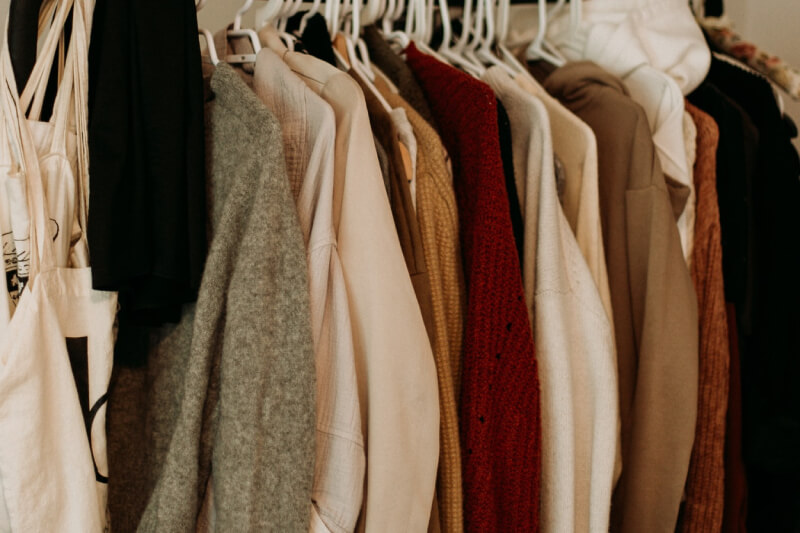When buying a new item of clothing, your biggest priority is durability, good quality, and minimal impact on animals and preserving the environment. At least it should be.
Did you know that 65% of clothing materials in fashion stores are made using synthetic materials detrimental to the environment?
Is there a better alternative? And what should you even look for when purchasing clothes?

Synthetic Fabrics
Many retailers sell clothes that have 100% polyester written on their tags. Polyester is actually a common plastic.
Synthetic fabrics used for creating apparel are primarily damaging to the environment because plastic takes more than 100 years to break down and recycle.

Manmade materials most commonly found in clothing stores include polyester, nylon, acrylic, polypropylene, and elastane.
The most significant advantages of synthetic fabrics are that they are durable during sports activities, don’t wrinkle easily, they’re cheap, and don’t shrink.
Common Natural Fabrics
Natural fabrics source their materials from plant fibres or animals.
Clothing shops will usually offer a faux version of these materials such as leather, fur, or wool.
Even though faux versions don't harm animals directly, they are still made using plastic materials and dyes that are extremely toxic to the environment. Considering all of these factors, buying the real thing second hand is still a viable option.
Cotton
Cotton is a common plant-based material in garment production. You can find it in virtually all clothing stores, and it is a comfortable and breathable material. Additionally, it is perfect for any season and hypoallergenic too.

Materials like 100% cotton can outlast polyester when it comes to wearability. However, organic cotton is the only environmentally friendly version of this material.
Cotton has a long history in clothing production, but it is not environmentally friendly.
Namely, it uses a lot of water resources. To make one cotton shirt, it takes 700 gallons of water, or in other words, enough water for an adult to stay hydrated for three years.
Viscose
Viscose is the most recognizable and frequently used cellulosic fibre. Cellulose is extracted from plant sources such as bamboo or trees. To the touch, it is similar to silk, but it is plant-based, unlike silk which is composed of fibroin, and produced by insect larvae.
Viscose is somewhat like cotton because it is light, breathable, and comfortable to wear during summer. Also, it imitates the luxurious look of silk but at a much lower price point.

Environmentally, bamboo fibre clothes are not as ideal as what they’re presented. On a positive note, bamboo does not require pesticides; it is sturdy and grows rapidly.
However, the chemical process of transforming bamboo into the garment is the downside as it takes a toll on the environment.
Wool
Wool is commonly used for winter garments. However, wool does not take up much of the world market. It has its share of around 1%, which is one wool sweater per person on the planet yearly.
It is a durable fabric and ideal for winter. However, it can shrink easily, and the way wool is acquired from animals causes them to suffer.

Silk
Derived from the silkworm, silk is an ancient material that is expensive, with the silk industry grossing 3.3 billion dollars per year.
The fabric is very comfortable, long-lasting, easy to drape; the texture is lightweight and soft.

Silk production is linked to animal cruelty as well since worms are often boiled alive in the process of silk production.
Leather
Leather is one of the oldest fabrics used for making clothes. Its appeal is that as a material it is lasting, biodegradable, durable and reusable.
However, it is not either animal or environmentally friendly as it causes water pollution and toxic waste that ends up in our ecosystems.

The Future of Fashion Materials
The fashion industry has recognised that its customers are likely to pay more for quality items and eco-friendly and cruelty-free products.
Most of the clothes that we throw away can’t be recycled, and it ends up in landfills for years.
The issue is also that accessories, shoes, and clothes in retail stores are made of combined materials.
One of the solutions could be 3D printing. That is the process of garment making that uses singular material (which makes the item recyclable after it is no longer wearable) and doesn’t involve sweatshops.
But there is a long way to go with this technique. At the moment, it is too expensive for mass consumption, and it takes a long time to produce one garment.
Some companies try to be as sustainable as possible, such as Reformation. Jaden Smith also recently launched a new design made out of recyclable fabric.

Final Word on Fabrics
The materials we mentioned above are the most common ones that you can purchase in popular stores. However, there are many other materials, such as semi-synthetic fabrics or novel textiles that we haven’t mentioned today.
The key is to find a balance with the fabrics that are comfortable, affordable, sustainable, and durable.
